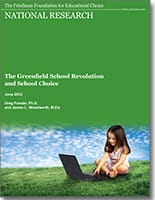 We know anecdotally that our current collection of private-school-choice programs has done little to encourage new and innovative models of private education to flourish. This report from the Friedman Foundation, which tracks private-school enrollment in eight choice-heavy locales over the lifespan of their tax-credit or voucher programs, offers evidence to back up those impressions: In Milwaukee, for example, the number of private schools has grown since choice legislation was enacted, but these schools have become larger and “presumably more stable and even insular” (and thus, less likely to be innovative). For authors Greg Forster and James L. Woodworth, this justifies a move toward universal school choice—making all children, regardless of income level, eligible for vouchers or tax credits—which, they argue, will allow for a shift in institutional culture, where entrepreneurs can “innovate beyond the confines of the ‘default’ public school model.” Or, to draw on Rick Hess’s terminology, universal choice will allow for the “greenfield schools model,” or a “rethink [of] how schools are designed from the ground up,” to take root. But why default to universal choice as the best way to reach greenfield schooling (apart from fact that promoting choice-for-all is the mission of the Friedman Foundation)? Following Forster’s and Woodworth’s own logic, upping the dollar value of vouchers (or tax credits) is more likely to prime the pump of supply-side innovation than simply opening the door to vouchers for more kids.
We know anecdotally that our current collection of private-school-choice programs has done little to encourage new and innovative models of private education to flourish. This report from the Friedman Foundation, which tracks private-school enrollment in eight choice-heavy locales over the lifespan of their tax-credit or voucher programs, offers evidence to back up those impressions: In Milwaukee, for example, the number of private schools has grown since choice legislation was enacted, but these schools have become larger and “presumably more stable and even insular” (and thus, less likely to be innovative). For authors Greg Forster and James L. Woodworth, this justifies a move toward universal school choice—making all children, regardless of income level, eligible for vouchers or tax credits—which, they argue, will allow for a shift in institutional culture, where entrepreneurs can “innovate beyond the confines of the ‘default’ public school model.” Or, to draw on Rick Hess’s terminology, universal choice will allow for the “greenfield schools model,” or a “rethink [of] how schools are designed from the ground up,” to take root. But why default to universal choice as the best way to reach greenfield schooling (apart from fact that promoting choice-for-all is the mission of the Friedman Foundation)? Following Forster’s and Woodworth’s own logic, upping the dollar value of vouchers (or tax credits) is more likely to prime the pump of supply-side innovation than simply opening the door to vouchers for more kids.
SOURCE: Greg Forster and James Woodworth, The Greenfield School Revolution and School Choice (Indianapolis, IN: The Friedman Foundation for Educational Choice, June 2012).
